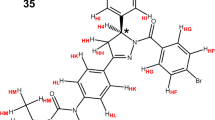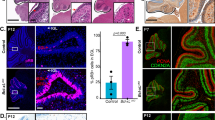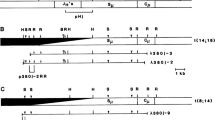Abstract
Studies of apoptosis in C. elegans have allowed the identification of three genes, ced-3, ced-4 and ced-9. Their products constitute the components of an induction pathway of apoptosis conserved in the nematode and mammals. In Drosophila, homologues have been found for CED-3, CED-4 and CED-9. CED-9 belongs to the Bcl-2 family which includes negative (Bcl-2) and positive (Bax) regulators of apoptosis. The recently discovered Bcl-2 family member named Drob-1 acts as a positive regulator of cell death. To address whether a Bcl-2 anti-apoptotic pathway exists in the fly, we studied the effects of expressing the mammalian genes bcl-2 in Drosophila. In embryos, expression of bcl-2 inhibits developmental and X-ray-induced apoptosis. Expressing bcl-2 or the pro-apoptotic mammalian bax in the developing eye and wing alters these structures, bcl-2 increasing the number of cells, while bax reduces the number of cells. In addition, the functional interaction between Bcl-2 and Bax is conserved. These results indicate that factors necessary for the activity of bcl-2 and bax are present in Drosophila. Therefore, a Bcl-2 pathway for inhibition of cell death may exist in the fly. Cell Death and Differentiation (2000) 7, 804–814
Similar content being viewed by others
Log in or create a free account to read this content
Gain free access to this article, as well as selected content from this journal and more on nature.com
or
Abbreviations
- AO:
-
acridine orange
- AEL:
-
after egg laying
- PCD:
-
programmed cell death
- AIF:
-
apoptosis inducing factor
- vg:
-
vestigial
- da:
-
daughterless
References
Ellis RE, Yuan JY and Horvitz HR . (1991) Mechanisms and functions of cell death. Annu. Rev. Cell Biol. 7: 663–698
Cryns V and Yuan J . (1998) Proteases to die for. Genes Dev. 12: 1551–1570
Nicholson DW and Thormberry NA . (1997) Caspases: killer proteases. Trends Biochem. Sci. 22: 299–306
Chen P, Rodriguez A, Erskine R, Thach T and Abrams JM . (1998) Dredd, a novel effector of the apoptosis activators Reaper, Grim, and Hid in Drosophila. Dev. Biol. 201: 202–216
Dorstyn L, Colussi PA, Quinn LM, Richardson H and Kumar S . (1999) DRONC, an ecdysone-inducible Drosophila caspase. Proc. Natl. Acad. Sci. USA 96: 4307–4312
Song Z, McCall K and Steller H . (1997) DCP-1, a Drosophila cell death protease essential for development. Science 275: 536–540
Fraser AG and Evan GI . (1997) Identification of a Drosophila melanogaster ICE/CED-3-related protease, drICE. EMBO J. 16: 2805–2813
Dorstyn L, Read SH, Quinn LM, Richardson H and Kumar S . (1999) DECAY, a novel Drosophila caspase related to mammalian caspase-3 and caspase-7. J. Biol. Chem. 274: 30778–30783
Zou H, Henzel WJ, Liu X, Lutschg A and Wang X . (1997) Apaf-1, a human protein homologous to C. elegans CED-4, participates in cytochromec-dependent activation of caspase-3. Cell 90: 405–413
Li P, Nijhawan D, Budihardjo I, Srinivasula SM, Ahmad M, Alnemri ES and Wang X . (1997) Cytochromec and dATP-dependent formation of Apaf-1/Caspase-9 complex initiates an apoptotic protease cascade. Cell 91: 479–489
Rodriguez A, Oliver H, Zou H, Chen P, Wang X and Abrams JM . (1999) Dark is a Drosophila homologue of Apaf-1/CED-4 and functions in an evolutionarily conserved death pathway. Nat. Cell Biol. 1: 272–279
Zhou I, Song Z, Tittel J and Steller H . (1999) HAC-1, a Drosophila homolog of Apaf-1 and Ced-4, functions in developmental and radiation-induced apoptosis. Mol. Cell 4: 745–755
Kanuka H, Sawamoto K, Inohara N, Matsuno K, Okano H and Miura M . (1999) Control of the cell death pathway by Dapaf-1, a Drosophila Apaf-1/Ced-4-related caspase activator. Mol. Cell 4: 757–769
Adams JM and Cory S . (1998) The Bcl-2 protein family: arbiters of cell survival. Science 281: 1322–1326
Gross A, McDonnell JM and Korsmeyer SJ . (1999) BCL-2 family members and the mitochondria in apoptosis. Genes Dev. 13: 1899–1911
Korsmeyer SJ . (1992) Bcl-2 initiates a new category of oncogenes: regulators of cell death. Blood 80: 879–886
Zhong LT, Sarafian T, Kane DJ, Charles AC, Mah SP, Edwards RH and Bredesen DE . (1993) bcl-2 inhibits death of central neural cells induced by multiple agents. Proc. Natl. Acad. Sci. USA 90: 4533–4537
Korsmeyer SJ . (1995) Regulators of cell death. Trends Genet. 11: 101–105
Hsu YT and Youle RJ . (1998) Bax in murine thymus is a soluble monomeric protein that displays differential detergent-induced conformations. J. Biol. Chem. 273: 10777–10783
Gross A, Jockel J, Wei MC and Korsmeyer SJ . (1998) Enforced dimerization of BAX results in its translocation, mitochondrial dysfunction and apoptosis. EMBO J. 17: 3878–3885
Xiang J, Chao DT and Korsmeyer SJ . (1996) BAX-induced cell death may not require interleukin 1β-converting enzyme-like proteases. Proc. Natl. Acad. Sci. USA 93: 14559–14563
Pastorino JG, Chen ST, Tafani M, Snyder JW and Farber JL . (1998) The overexpression of Bax produces cell death upon induction of the mitochondrial permeability transition. J. Biol. Chem. 273: 7770–7775
Finucane DM, Bossy-Wetzel E, Waterhouse NJ, Cotter TG and Green DR . (1999) Bax-induced caspase activation and apoptosis via cytochromec release from mitochondria is inhibitable by Bcl-xL. J. Biol. Chem. 274: 2225–2233.
Oltvai ZN, Milliman CL and Korsmeyer SJ . (1993) bcl-2 heterodimerizes in vivo with a conserved homolog, bax, that accelerates programmed cell death. Cell 74: 609–619
Sedlak TW, Oltvai ZN, Yang E, Wang K, Boise LH, Thompson CB and Korsmeyer SJ . (1995) Multiple Bcl-2 family members demonstrate selective dimerizations with Bax. Proc. Natl. Acad. Sci. USA 92: 7834–7838
Cheng EH, Levine B, Boise LH, Thompson CB and Hardwick JM . (1996) Bax-independent inhibition of apoptosis by Bcl-xL . Nature 379: 554–556
Knudson CM and Korsmeyer SJ . (1997) Bcl-2 and Bax function independently to regulate cell death. Nat. Genet. 16: 358–363
Golstein P . (1997) Controlling Cell Death. Science 275: 1081–1082.
Shaham S and Horvitz HR . (1996) An alternatively spliced C. elegans ced-4 RNA encodes a novel cell death inhibitor. Cell 86: 201–208
Hengartner MO . (1997) Apoptosis. CED-4 is a stranger no more. Nature 388: 714–715
Chinnaiyan AM, O'Rourke K, Lane BR and Dixit VM . (1997) Interaction of CED-4 with CED-3 and CED-9: a molecular framework for cell death. Science 275: 1122–1126
Moriishi K, Huang DC, Cory S and Adams JM . (1999) Bcl-2 family members do not inhibit apoptosis by binding the caspase activator Apaf-1. Proc. Natl. Acad. Sci. USA 96: 9683–9688
Zhu W, Cowie A, Wasfy GW, Penn LZ, Leber B and Andrews DW . (1996) Bcl-2 mutants with restricted subcellular location reveal spatially distinct pathways for apoptosis in different cell types. EMBO J. 15: 4130–4141
Lam M, Dubyak G, Chen L, Nunez G, Miesfeld RL and Distelhorst CW . (1994) Evidence that BCL-2 represses apoptosis by regulating endoplasmic reticulum-associated Ca2+ fluxes. Proc.Natl. Acad. Sci. USA 91: 6569–6573
Distehorst CW, Lam M and McCormick TS . (1996) Bcl-2 inhibits hydrogen peroxide-induced ER Ca2+ pool depletion. Oncogene 12: 2051–2055
He H, Lam M, McCormick TS and Distelhorst CW . (1997) Maintenance of Calcium Homeostasis in the Endoplasmic Reticulum by Bcl-2. J. Cell. Biol. 138: 1219–1228
Ryan JJ, Prochownik E, Gottlieb CA, Apel IJ, Merino R, Nunez G and Clarke MF . (1994) c-myc and bcl-2 modulate p53 function by altering p53 subcellular trafficking during the cell cycle. Proc. Natl. Acad. Sci. USA 91: 5878–5882
Kroemer G, Zamzami N and Susin SA . (1997) Mitochondrial control of apoptosis. Immunol. Today 18: 44–51
Reed JC . (1997) Double identity for proteins of the Bcl-2 family. Nature 387: 773–776
Mignotte B and Vayssière JL . (1998) Mitochondria and apoptosis. Eur. J. Biochem. 252: 1–15
Susin SA, Lorenzo HK, Zamzami N, Marzo I, Snow BE, Brothers GM, Mangion J, Jacotot E, Costantini P, Loeffler M, Larochette N, Goodlett DR, Aebersold R, Siderovski DP, Penninger JM and Kroemer G . (1999) Molecular characterization of mitochondrial apoptosis-inducing factor. Nature 397: 441–446
Susin SA, Lorenzo HK, Zamzami N, Marzo I, Brenner C, Larochette N, Prevost MC, Alzari PM and Kroemer G . (1999) Mitochondrial release of caspase-2 and -9 during the apoptotic process. J. Exp. Med. 189: 381–394
Bergmann A, Agapite J and Steller H . (1998) Mechanisms and control of programmed cell death in invertebrates. Oncogene 17: 3215–3223
Abrams JM . (1999) An emerging blueprint for apoptosis in Drosophila. Trends Cell Biol. 9: 435–440
LaCasse EC, Baird S, Korneluk RG and MacKenzie AE . (1998) The inhibitors of apoptosis (IAPs) and their emerging role in cancer. Oncogene 17: 3247–3259
Wang SL, Hawkins CJ, Yoo SJ, Muller HA and Hay BA . (1999) The Drosophila caspase inhibitor DIAP1 is essential for cell survival and is negatively regulated by HID. Cell 98: 453–463
Haining WN, Carboy-Newcomb C, Wei CL and Steller H . (1999) The proapoptotic function of Drosophila Hid is conserved in mammalian cells. Proc. Natl. Acad. Sci. (USA) 96: 4936–4941
McCarthy JV and Dixit VM . (1998) Apoptosis induced by Drosophila reaper and grim in a human system. Attenuation by inhibitor of apoptosis proteins (ciaps). J. Biol. Chem. 273: 24009–24015
Claveria C, Albar JP, Serrano A, Buesa JM, Barbero JL, Martinez AC and Torres M . (1998) Drosophila grim induces apoptosis in mammalian cells. EMBO J. 17: 7199–7208
Vucic D, Seshagiri S and Miller LK . (1997) Characterization of reaper- and FADD-induced apoptosis in a lepidopteran cell line. Mol. Cell. Biol. 17: 667–676
Hisahara S, Kanuka H, Shoji Si, Yoshikawa S, Okano H and Miura M . (1998) Caenorhabditis elegans anti-apoptotic gene ced-9 prevents ced-3-induced cell death in Drosophila cells. J. Cell. Sci. 111: 667–673
Shigenaga A, Kimura K, Kobayakawa Y, Tsujimoto Y and Tanimura T . (1997) Cell ablation by ectopic expression of cell death genes, ced-3 and Ice, in Drosophila. Dev. Growth Differ. 39: 429–436
Kanuka H, Hisahara S, Sawamoto K, Shoji S, Okano H and Miura M . (1999) Proapoptotic activity of Caenorhabditis elegans CED-4 protein in Drosophila: implicated mechanisms for caspase activation. Proc. Natl. Acad. Sci. USA 96: 145–150
Brand AH and Perrimon N . (1993) Targeted gene expression as a means of altering cell fates and generating dominant phenotypes. Development 118: 401–415
Abrams JM, White K, Fessler LI and Steller H . (1993) Programmed cell death during Drosophila embryogenesis. Development 117: 29–43
Pazdera TM, Janardhan P and Minden JS . (1998) Patterned epidermal cell death in wild-type and segment polarity mutant. Development 125: 3427–3436
Hay BA, Wolff T and Rubin GM . (1994) Expression of baculovirus P35 prevents cell death in Drosophila. Development 120: 2121–2129
Freeman M . (1997) Personal communication to FlyBase: http://flybase.bio.indiana.edu/.bin/fbpcq.html?FBrf0091569.
White K, Tahaoglu E and Steller H . (1996) Cell killing by the Drosophila gene reaper. Science 271: 805–807
Kurada P and White K . (1998) Ras promotes cell survival in Drosophila by downregulating hid. Cell 95: 319–329
Chen P, Nordstrom W, Gish B and Abrams JM . (1996) Grim, a novel cell death gene in Drosophila. Genes Dev. 10: 1773–1782
Wolff T and Ready DF . (1991) Cell death in normal and rough eye mutants of Drosophila. Development 113: 825–839
Milan M, Campuzano S and Garcia-Bellido A . (1997) Developmental parameters of cell death in the wing disc of Drosophila. Proc. Natl. Acad. Sci. USA 94: 5691–5696
Wang K, Gross A, Waksman G and Korsmeyer SJ . (1998) Mutagenesis of the BH3 domain of BAX identifies residues critical for dimerization and killing. Mol. Cell Biol. 18: 6083–6089
Igaki T, Kanuka H, Inohara N, Sawamoto K, Nunez G, Okano H and Miura M . (2000) Drob-1, a Drosophila member of the bcl-2/CED-9 family that promotes cell death. Proc. Natl. Acad. Sci. USA 97: 662–667
Evans EK, Kuwana T, Strum SL, Smith JJ, Newmeyer DD and Kornbluth S . (1997) Reaper-induced apoptosis in a vertebrate system. EMBO J. 16: 7372–7381
White K, Grether ME, Abrams JM, Young L, Farrell K and Steller H . (1994) Genetic control of programmed cell death in Drosophila. Science 264: 677–683
Nordstrom W, Chen P, Steller H and Abrams JM . (1996) Activation of the reaper gene during ectopic cell killing in Drosophila. Dev. Biol. 180: 213–226
Kluck RM, Bossy-Wetzel E, Green DR and Newmeyer DD . (1997) The release of cytochromec from mitochondria: a primary site for Bcl-2 regulation of apoptosis. Science 275: 1132–1136
Yang J, Liu X, Bhalla K, Kim CN, Ibrado AM, Cai J, Peng TI, Jones DP and Wang X . (1997) Prevention of apoptosis by Bcl-2: release of cytochromec from mitochondria blocked. Science 275: 1129–1132
Alnemri ES, Robertson NM, Fernandes TF, Croce CM and Litwack G . (1992) Overexpressed full-length human BCL2 extends the survival of baculovirus-Infected sf9 insect cells. Proc. Natl. Acad. Sci. USA 89: 7295–7299
Varkey J, Chen P, Jemmerson R and Abrams JM . (1999) Altered cytochromec display precedes apoptotic cell death in Drosophila. J. Cell Biol. 144: 701–710
Oh JH, Choi WS, Kim JE, Seo JW, O'Malley KL and Oh YJ . (1998) Overexpression of HA-Bax but not Bcl-2 or Bcl-XL attenuates 6-hydroxy dopamine-induced neuronal apoptosis. Exp. Neurol. 154: 193–198
Wiessner C, Allegrini PR, Rupalla K, Sauer D, Oltersdorf T, McGregor AL, Bischoff S, Bottiger BW and van der Putten H . (1999) Neuron-specific transgene expression of Bcl-XL but not Bcl-2 genes. Neurosci. Lett. 268: 119–122
Wang HD, Fukuda T, Suzuki T, Hashimoto K, Liou SY, Momoi T, Kosaka T, Yamamoto K and Nakanishi H . (1999) Differential effects of Bcl-2 overexpression on hippocampal CA1 neurons. J. Neurosci. Res. 57: 1–12
Schierle GS, Leist M, Martinou JC, Widner H, Nicotera P and Brundin P . (1999) Differential effects of Bcl-2 overexpression on fibre outgrowth and survival of embryonic dopaminergic neurons in intracerebral transplants. Eur. J. Neurosci. 11: 3073–3081
Wing JP, Zhou L, Schwatz LM and Nambu JR . (1998) Distinct cell killing properties of the Drosophila reaper, head involution defective, and grim genes. Cell Death Differ. 5: 930–939
Grether ME, Abrams JM, Agapite J, White K and Steller H . (1995) The head involution defective gene of Drosophila melanogaster functions in programmed cell death. Genes Dev. 9: 1694–1708
Wodarz A, Hinz U, Engelbert M and Knust E . (1995) Expression of crumbs confers apical character on plasma membrane. Cell 82: 67–76
Simmonds AJ, Brook WJ, Cohen SM and Bell JB . (1995) Distinguishable functions for engrailed and invected in anterior-posterior patterning in the Drosophila wing. Nature 376: 424–427
Spradling AC and Rubin GM . (1982) Transposition of cloned P elements into Drosophila germ line. Science 218: 341–347
Rubin GM and Spradling AC . (1982) Genetic transformation of Drosophila with transposable element vectors. Science 218: 348–353
Robertson HM, Preston CR, Phillis RW, Johnson-Schlitz DM, Benz WK and Engels WR . (1988) A stable genomic source of P element transposase in Drosophila. Genetics 118: 461–470
Tomlinson A and Ready DF . (1987) Cell fate in the Drosophila ommatidium. Dev. Biol. 123: 264–275
Acknowledgements
We thank Anne-Marie-Pret for her critical reading of the manuscript. We are indebted to Jeryl Degrolard (INRA, Jouy-en-Josas) who performed electron microscopy studies, Jacqueline Mesnard for expert technical assistance with eye sections and Michel Laurent (UPS, Orsay) for confocal microscopy analysis. This work was supported in part by grants from the Association pour la Recherche contre le Cancer (No. 9517). S Gaumer was a recipient of a fellowship from the Ligue Nationale Contre le Cancer. We are grateful to the Conseil régional d'Ile-de-France, the Association pour la Recherche contre le Cancer, the Ligue Nationale Contre le Cancer, and the Fondation pour la Recherche Médicale which all contributed financial support towards equipment used in our laboratories.
Author information
Authors and Affiliations
Corresponding author
Additional information
Edited by L Schwartz
Rights and permissions
About this article
Cite this article
Gaumer, S., Guénal, I., Brun, S. et al. Bcl-2 and Bax mammalian regulators of apoptosis are functional in Drosophila. Cell Death Differ 7, 804–814 (2000). https://doi.org/10.1038/sj.cdd.4400714
Received:
Revised:
Accepted:
Published:
Issue date:
DOI: https://doi.org/10.1038/sj.cdd.4400714
Keywords
This article is cited by
-
Network pharmacology and molecular docking–based investigation of monocyte locomotion inhibitory factor attenuates traumatic brain injury by regulating aquaporin 4 expression
Naunyn-Schmiedeberg's Archives of Pharmacology (2024)
-
Assessment of Epiregulin Effect and its Combination with Gonadotropins on Proliferation, Apoptosis, and Secretory Activity by Human Ovarian Cells
Reproductive Sciences (2023)
-
Interrelationships Between miR-34a and FSH in the Control of Porcine Ovarian Cell Functions
Reproductive Sciences (2023)
-
HOXA-AS2 enhances GBM cell malignancy by suppressing miR-2116-3p thereby upregulating SERPINA3
BMC Cancer (2022)
-
Evaluation of the cytotoxic anticancer effect of polysaccharide of Nepeta septemcrenata
Beni-Suef University Journal of Basic and Applied Sciences (2021)



